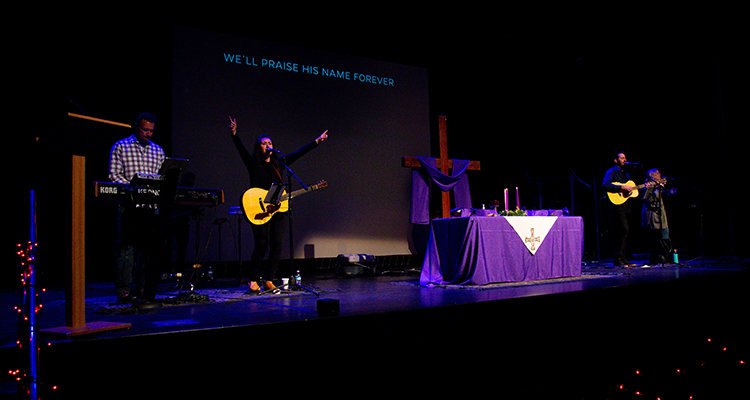Contemporary Versus Traditional Lighting for Churches

New Life Church, Colorado Springs, Colorado. Photo courtesy of Scott LeBeau.
If your church already offers different weekly services — one traditional and the other contemporary — how one approaches each is crucial to the continued growth of the church. Congregation members benefit by choosing which suits them best. When differentiating between each type of service, lighting is an extremely key place to start.
In determining what to incorporate for each type of service, things can differ from place to place. In Tulsa, Oklahoma, Asbury United Methodist Church Worship and Media Administrator Tim Ottley said, “One should determine a kind of an identity (for each service), and stick with that.”
Most importantly, what story is your church trying to tell?
Bigger Numbers, More Brightness
At Asbury, for example, Ottley noted, the lighting differences between a traditional and contemporary service are significant. Prior to the pandemic, the church typically hosted traditional services with over 100 people on stage, comprised mostly of a large choir. By contrast, its contemporary service, would run around 10 on stage, led by a worship band. “When you are lighting 100 people, you’ll use a lot of light,” he added.
In addition, Ottley explained how each type of Asbury service has its lighting vary significantly. At a contemporary service, for instance, the music is a “little more dynamic.” It leads to there being “a lot more change in the lighting. During traditional services, the songs tend to be more consistent in their tone.”
In terms of what “more dynamic” translates to, relating to lighting for contemporary services, Scott LeBeau, production lighting director at New Life Church in Colorado Springs, Colorado, offered some insight.
“You are trying to be more complimentary to the music, looking for movement and texturing.” During such services, he added he works to have “more saturations into whites, and into CTO [color temperature orange], so it has a gold field.”
By contrast, in traditional services, LeBeau said, “You have your wash, don’t have moving fixtures, and instead have static LEDs. As a result, we don’t do a lot of color changes.”
Learning From a Different View
To get a grasp on necessary lighting changes, LeBeau pointed to not being behind the console each week.
He said, “You need to see how does this look, how does this feel, from a congregant’s perspective?” From that vantage point, it can help when deciding on a church’s lighting needs, avoiding being caught up on wants.
To successfully make the necessary lighting changes during a service, there is particular lighting infrastructure to make it happen.
For LeBeau, “a controller will allow you to do that. A console allows me to paint that picture.” Without a quality console he cautioned, “you are kind of stuck, until making that upgrade.” While less expensive lighting programs are on the market, LeBeau cited being limited in terms of having the flexibility, ebb and flow capability required during a contemporary service.
With so many lighting options available for use within in a church, it can be tough to easily figure what types of lighting fixtures are best suited for one’s space.

New Life Church, Colorado Springs, Colorado. Photo courtesy of Scott LeBeau.
“From LEDs to moving lights to pattern lights, to gobos and lasers, find out who you are. It’s to see what’s the best fit,” said Ottley. Describing the value of moving lights, for either type of service, he said, “they save you from buying six to 10 lights in those particular positions.” It allows one to incorporate a “little bit of color, or a change of hue in the lights. That little bit of color when setting the mood … there’s a place for that.”
Finding Ways to Save
For LeBeau, an ideal option to lower the cost on lighting projects is LED tape to build LED fixtures, particularly for smaller churches.
“Right now, the project I am working on should be around $40,000. We are doing it for $4,000,” he said. “If someone has the ability to solder, it can make a huge difference in a stage design. You have to dream, and then find how it can come to life.”
For churches looking how to best use their available lighting, without no additional investment, LeBeau pointed to fixture placement. In particular, “How can we re-utilize something to benefit both services?” he asked. One example he mentioned was in repositioning an LED light and RGBW LED fixture, to where it is lighting the stage as a front wash for one service, but then repositioned as a back wash on a wall, for another.
However, at Asbury, there isn’t a piece of lighting gear solely used for one type of service. It’s how they are used.
“For both our services, we use all our gear. I use it slightly different, with a bit more color and a bit more movement (for contemporary services),” explained Ottley.
Regardless of the type of service, the goal should be the same for either type of service, explained LeBeau. “The heart of it should be the same, toward drawing people into the presence of the Lord visually.”
Avoid Drastic Changes
When a lighting director is considering making major changes to the lighting, both Ottley and LeBeau agreed to do so incrementally.
In making changes too quickly, “dramatic change can be a distraction,” explained Ottley. “We are not to be seen. We are trying to focus on God, who is the focus during worship.”


